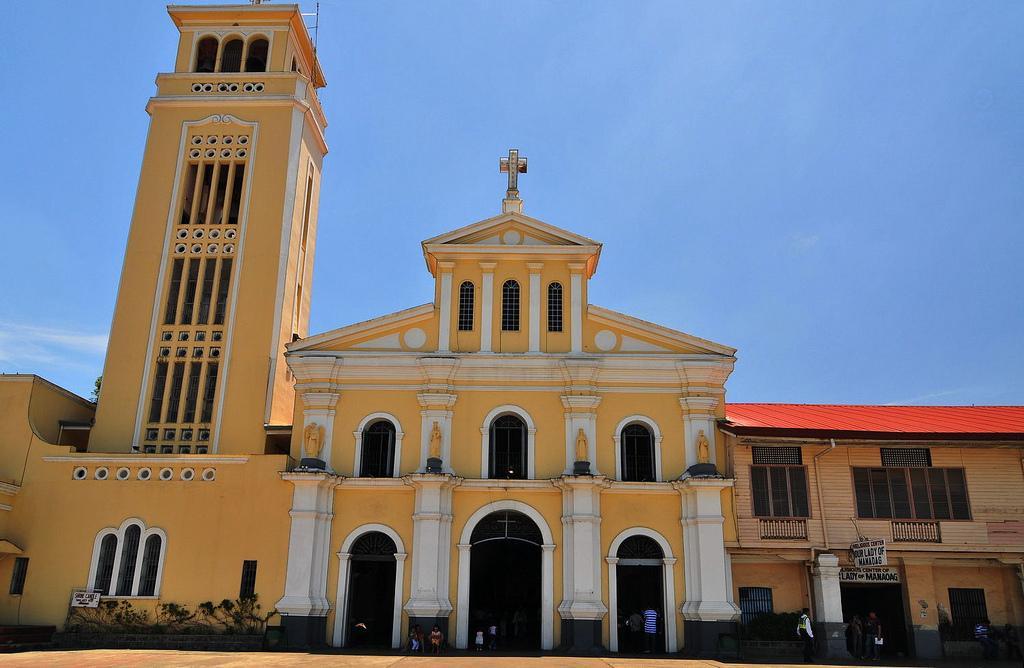
Our Lady of the Rosary of Manaoag in Pangasinan is a 17th-century Roman Catholic shrine where the ivory image of the Blessed Virgin Mary is placed in the high altar. Under that invocation, Mary the mother of Jesus is locally venerated as the patroness of the town and is often referred to in both the Pangasinense and Ilocano dialect as Apo Baket, in English, "Venerable Madam."
The image is one of the most venerated Marian images in the country, and held by believers to possess healing powers as patroness of the sick, the helpless and the needy. The Manaoag Shrine is administered by the Dominican Order under the Archdiocese of Lingayen-Dagupan, and today, it is an active parish serving Manaoag and the surrounding towns.
A marvelous name
Tradition holds the town itself was born from the Virgin Mary’s call or "taoag" to the young man. The term manaoag was derived from this, and means "She Calls."
A wondrous history
The original image was brought to the area by Augustinian friars who spiritually administered Manaoag from 1590-1613 in accordance with Royal Spanish decree. In 1614, the Dominicans assumed spiritual leadership under the patronage of Saint Monica.
In the early 17th century, the ivory image was brought to the Philippines by Padre Juan de San Jacinto from Spain via Acapulco. Documents dating back to 1610 attest that a native man walking home heard a mysterious female voice. He looked around and saw on a cloud-veiled treetop an apparition of the Blessed Virgin Mary, holding a rosary in her right hand and the Child Jesus in her left. The man fell on his knees and later told others of the miracle. On the spot where St. Mary appeared to the man, a chapel was built, and the present-day town quickly grew around it.
A huge crowd attended the canonical coronation of the image on 21 April 1926 by the then-Papal Nuncio, as authorized by Pope Pius XI. After surviving Japanese bombing during World War II, the church was rebuilt, and it celebrated the Diamond Jubilee of the image's coronation on 1 January 2000.
Cardinal Bernard Francis Law, Archpriest of the Papal Basilica of Saint Mary Major in Rome, with permission of Pope Benedict XVI, granted a plenary indulgence to visitors equal to that received when visiting a papal basilica in Rome. This was confirmed by the prelate (now Archbishop) of the Lingayen-Dagupan Diocese, Socrates B. Villegas, in a circular dated 13 June 2011. Within the country, only the Manaoag Shrine currently holds this status.
Pope Benedict XVI canonically approved the grant of the plenary indulgence on 21 June 2011. The official document and a shrine official who was among the priests who went to Rome confirmed the plenary indulgence may be obtained on each visit to the shrine subject to three conditions for each occasion: (1) going to confession immediately before or after the pilgrimage; (2) receiving the Eucharist during the pilgrimage; and (3) praying for the intentions of the Pope; each done in a spirit of detachment from the attraction of sin.
On 22 July 2011, a special mass was held to affirm the spiritual bond of affinity between Manaoag Shrine and the Papal Basilica of Saint Mary Major in Rome.

Some Astonishing Miracles
Our Lady of Manaoag has a long history of renowned miraculous and pious events, with some of the earliest are replicated in the murals within the church. These include the miraculous sparing of the town from a wildfire, the origin of the basilica and the parish, and the original apparition. Devotees visiting the shrine usually pray for good health or cure for diseases, among other intentions.
- One story recounts how in the early days of Spanish colonization, animist mountain tribes burnt down newly-converted Christian villages. The town of Manaoag was among the settlements set afire, and the initial thatch-roofed church was the locals' last refuge. The leader of the pillagers climbed over the compound's crude fence and shot flaming arrows into all parts of the church, but the building miraculously did not ignite.
- The statue's miraculous powers became famous in the 1940s. During World War II, the Japanese dropped several bombs within the church's vicinity, with the structure itself suffering moderate damage. Four bombs were released above the church, with three landing on the plaza and the façade, destroying both. The last bomb fell in the church sanctuary, but it remained intact and did not explode.


Regalia and security
The original icon of Our Lady of Manaoag is considered priceless, as is its bejeweled crown. There have been several attempts to burglaries the Manaoag Shrine due to the jewels sewn into the icon's dress and regalia.
Several golden crowns and haloes are deposited at the shrine's museum, which were donated by both Filipino and foreign devotees. An expensive collection of liturgical vestments that have been used by the image and the Dominican priests are also on display. A large array of lavishly elegant perfumes is likewise showcased; these were donated by devotees and pilgrims from around the world as ex votos or presents to the image.
The image of is fully secured with bulletproof glass panels enclosing it on three sides above the old high altar. The archdiocese, reckoning the Filipino custom of touching a venerated image or its clothing, constructed a staircase that rises to the second floor behind the altar. This touching gallery has pews, and people queue to kneel at the alcove behind the image's shrine. Supplicants place their hands through bars and touch the lower part of the image's mantle, and may deposit prayers in a small box on the kneeler's surface. After touching the mantle and praying, devotees pass through the religious souvenir shop on their way out.

Services
The feast of Our Lady of Manaoag is on the third Wednesday after Easter. It also celebrates the universal feast day of Our Lady of the Holy Rosary every first Sunday of October.
Every year, thousands of pilgrims continue to flock to the Manaoag Shrine. The 4 a.m. procession and dawn rosary every first Saturday before the 5 a.m. Mass is well-attended by pilgrims mostly from Metro Manila and from Regions I (Ilocos), II (Cagayan Valley), and III (Central Luzon). There are staunch devotees coming from Metro Manila who remarkably hear Mass every week.
The blessing of religious articles and vehicles is performed at the back of the church grounds after every Mass. Holy water is dispensed free to those with receptacles ready. Masses for petitions and thanksgiving may be offered during the regular schedule, while Masses for the dead may be offered on any Friday.
St Hedwig's Parish, Chicago
One of Chicago's Polish cathedrals, St Hedwig's Roman Catholic Church has a shrine of Our Lady of Manaoag in a side altar. In April 2008, a fire from the basement burnt a 15 by 3-foot hole under the altar, destroying the statue brought by devotees. A replacement statue has been sent in its place.
Visit Manaoag
The shrine is the most visited religious destination north of Manila. If you are planning to visit, these are buses that passing through Lingayen - capital of Pangasinan:
- Dagupan Bus Line (Quezon City to Dagupan)
- Victory Liner (Quezon City to Dagupan & Alaminos)
- Five Star Bus Line (Pasay City to Dagupan & Bolinao)
- City Trans (Manila to Dagupan & Bolinao)
- Philippine Rabbit (Quezon City to Dagupan & Bolinao)
- Philippine Rapid Manila to Dagupan & Bolinao)










